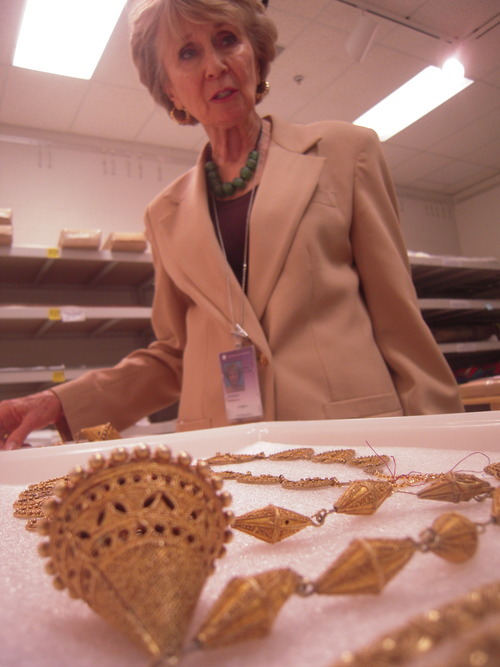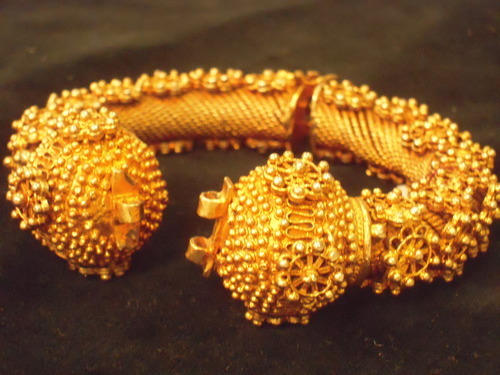This is an archived article that was published on sltrib.com in 2011, and information in the article may be outdated. It is provided only for personal research purposes and may not be reprinted.
Washington • Marian Ashby Johnson picked up her first piece of gold jewelry in the West Africa country of Senegal some 47 years ago, thinking it was a neat artifact to treasure from the time she and her husband spent there.
Several return trips and market visits later, the Provo native is handing over to the Smithsonian museum one of the largest existing collections of Senegalese jewelry.
Johnson, a former professor of art history at Brigham Young University, has spent the past month in Washington helping to inventory some 250 items of the laboriously handcrafted jewelry that set, in many ways, the standard for goldsmiths in that region of Africa.
"This is their art," Johnson says. "As far as I'm concerned, this is their traditional art."
It's not the typical art that one might think of as African, art that often comes in the form of woodcarvings, masks, statuettes and ivory carvings.
And that's what Johnson says makes it so special.
"It isn't even on any list of art regions in any book," she says.
Johnson and her husband, G. Wesley Johnson, first went to Senegal in 1964 while her husband was working on his dissertation on the rise of nationalism in the former French colony. He was also a BYU professor.
They spent a year traveling the country, and Marian Johnson began collecting. She would visit markets and search out rare pieces, asking longtime residents where she could find the best goldsmiths.
Her great finds now lie in trays in a concrete-walled room underneath the National Mall with other treasures from Africa not yet on display.
Bracelets, chains, necklaces, earrings — some covered in gold, some solid gold. Other pieces are from more inexpensive metals, but crafted into detailed beading and designs.
There are no stones, no gems in Senegal jewelry, but there is intricate gold work, some imitating flowers or baskets of flowers and a few with half-moons, a nod, perhaps, to the Islamic influence in the region.
Johnson points out one chain from which hangs an item called a korval, a bulb covered in tiny balls of gold that she notes were held by tweezers while the creator soldered them into place and used a tube to cool them.
"These are done especially elegantly," Johnson says.
Many of the items have so far been on display only in the Johnson's Provo home, or for many years, stuck in storage boxes. Marian Johnson wanted to change that and looked for a way to allow others to view the majesty of her collection.
"I think it's appreciated here," she says after spending a month at the Smithsonian museum as a visiting fellow helping to inventory the objects. "This is a research institution where I thought the jewelry should show up."
Bryna Freyer, a senior curator at the museum, says the collection is remarkable mainly for the fact that jewelry often gets melted down and re-formed over time, making it even more difficult to find such varied items in one lot.
Plus, Freyer notes, the collection may draw people to the museum who otherwise may not come.
"I'm excited because I look at it and I see how it fits into our collection of gold from the Ivory Coast and Ghana, and look at its technical expertise and the long history" of goldsmiths creating such adornments, Freyer says. "I have to admit the general public will look at it [and go], 'Ooh, aah,' and I think they'll be able to appreciate the history and the sheer 'how did they do that?' of the technique."
It's unclear when the collection will be available to the public, though a few items may find their way into displays as early as next year.
There's still much left to do: create a catalog of the items and seek out grants to help fund a public showing and a possible road tour as well as promotion of the collection.
Freyer says one of the best parts of Johnson's donation is that it comes from her own field work as an art history professor, putting more of a historical perspective and background with the items.
"It's not just these [pieces] in a case; there are other things going on around it," Freyer says.
The National Museum of African Art on the National Mall is the only American museum solely dedicated to the conservation, study and exhibition of arts of the continent. The museum includes more than 9,000 objects, including textiles, photography, sculpture, pottery, paintings and jewelry.





